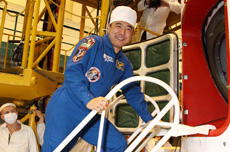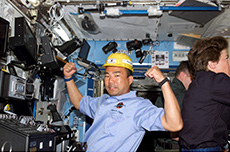Q. What shuttle mission left a particularly strong impression on you?
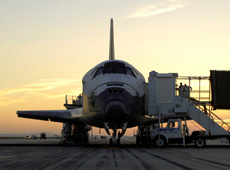
Space Shuttle Discovery after returning to Earth (STS-114) (courtesy: NASA)
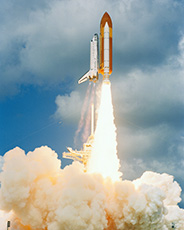
STS-114 launch. A piece of insulation fell off of the Space Shuttle’s external fuel tank afterwards. (courtesy: NASA)
The one I remember the most is the “Return to Flight” mission in July 2005 (STS-114), which included astronaut Soichi Noguchi. It wasn’t just the first launch since the Columbia accident two-and-a-half years before. It was also my first mission after moving to my current position, so I remember being incredibly nervous.
At the time Noguchi was absolutely determined to fly into space, so I wanted to help him get there. But I didn’t want him to go unless the Space Shuttle was confirmed to be safe in our eyes. That’s why JAXA formed a special investigation team and double-checked NASA’s safety-management process in detail, occasionally visiting NASA to confirm in person. We judged things to be okay, and so JAXA decided to let Noguchi board the Space Shuttle.
But even so, I was still apprehensive during the launch, and I couldn’t relax until they came back. Besides, during this mission, a piece of insulation foam again came off of the external fuel tank after launch and damaged some of the Space Shuttle’s heat resistant tiles. The mission ended safely, but when I heard the report my nerves shot through the roof. Until they returned to Earth, I was constantly at the ready to do whatever I could if anything happened.
Q. What lessons did you learn from the Columbia accident?
I had always known that manned spaceflight was inherently risky, but this was a reminder that just one oversight could lead to a terrible disaster. After the accident, JAXA also made its pre-flight preparations more thorough. We speculated on various hazards, designed measures to eliminate the hazards, and then tested these defensive measures to make sure they would work. That’s how we prepared for any problems that could occur.
Also, the Columbia disaster made me think differently about the support we provide to the astronauts’ families. I always tried to talk honestly with them and not hide anything, no matter what happened on a mission. That’s why when a peace of insulation foam fell off during the launch of STS-114, I met with Noguchi’s wife in person rather than calling her on the telephone, and explained things clearly so she would understand the situation. I think there’s nothing scarier than the unknown, so if we are straightforward with family members, they trust us. If we answer their questions in a half-hearted manner, it just makes things worse, so we need to learn how to give them all the answers they want. One lesson I learned from the Columbia accident is a different way of thinking about the nature of support we provide to the families.
Q. What effect do you think the Space Shuttle’s retirement will have on Japan’s manned space program?
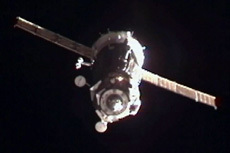
Satoshi Furukawa and other astronauts on the Soyuz TMA-20 spacecraft (courtesy: JAXA/NASA)
The biggest effect is that it reduces our spaceflight opportunities. But I also think that since our astronauts will be flying on Russia’s Soyuz spacecraft, we will have a good chance to learn about Russian manned spaceflight technology and methods in addition to American. Unlike the Space Shuttle, which is a winged spacecraft, the Soyuz is a capsule. I’d like us to learn more about using capsule spacecraft by training and flying on the Soyuz. I also think that we Japanese need to make the most of our opportunities to join long-stay missions on the International Space Station and produce good results.

